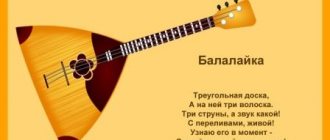Topic: “Dramatic image in music”
This music lesson for 7th grade students was developed based on the “Music” program (authors T.I. Naumenko, V.V. Aleev)
The lesson was designed taking into account those skills and methods of action that children are already familiar with: musical greetings, and have experience of emotional sensations of a different nature. At the previous lesson, the children listened to “Prelude” by S.V. Rachmaninov and learned that music has various musical images - lyrical, dramatic, epic.
The purpose of the lesson: - to develop an emotionally conscious perception of a musical image using the example of the ballad “The King of the Forest” by F. Schubert. - identifying the means of expression of different types of arts (literary, musical and visual) in creating a single image. Lesson type: Learning new material
Lesson objectives:
1. Educational:
a) continue to teach students to compare and contrast poetry, music and visual arts, b) come up with a new concept of “ballad”.
2. Developmental:
a) further development of listening culture,
b) continue to develop students’ active, felt, conscious perception of music, poetry, fine arts,
c) develop cantilena singing skills.
3. Educational:
a) arouse interest in the work of the composer Franz Schubert and the poetry of Goethe.
Methods and techniques:
Verbal (conversation, explanation)
Visual (portraits, illustrations)
Listening to music
Singing
Visibility:
Portraits of Franz Schubert, Johann Goethe. Illustrations. Predicted result: concepts: ballad methods of action: working with cards, listening to music. Judgments: personal attitude towards music
Lesson topic:
"Dramatic image in music"
Lesson progress Organizational moment
I. Students enter the classroom and greet the teacher with a musical greeting.
II. Updating basic knowledge:
What is a musical image?
With the help of what means of musical expressiveness can a composer reflect the surrounding reality (melody, tempo, register, dynamics).
What assignment did you receive in the last lesson? (draw an autumn landscape, find a poem corresponding to the musical image of S.V. Rachmaninov’s “Prelude”), read fragments of poems (against the background of the autumn landscape and the sound of Rachmaninov’s music)
What is foreplay?
Main part
Teacher: Dramatic images, like lyrical ones, are very widely represented in music. On the one hand, they arise in music based on dramatic literary works (such as opera, ballet and other stage genres), but much more often the concept of “dramatic” is associated in music with character traits, musical interpretation of characters and images. Today we will continue the conversation about musical images. An example of a dramatic work is Franz Schubert’s ballad “The Forest King,” written to a poem by the great German poet J. V. Goethe. (portrait of Franz Schubert on the screen) Brief message about the life and work of the composer Franz Schubert, the great Austrian composer of the 19th century, wrote so many wonderful works during his short life that they could hardly fit into 37 thick volumes: symphonies, vocal works, piano pieces and much more other. The main place in his work was occupied by the song genre (about 600), which he raised to a high artistic level. A Schubert song is always a living scene, a dramatic picture in which the subtlest shades of human feelings are revealed. He wrote most of his works for Viennese societies of music lovers, for his friends, meetings with whom were called Schubertiads. (illustration on screen) (portrait of Goethe on screen) Franz Schubert was fascinated by Goethe's poetry. She excited and captivated the imagination, mind, and soul of the young composer. Over 70 songs were written by Schubert to the words of the great German poet. Schubert wrote the ballad “The Forest King” when he was only 18 years old. This is how one of his friends describes the birth of this song: “We found Schubert in a completely heated state, loudly reading from a book of The Forest King.” He walked with the book back and forth around the room several times, suddenly sat down, and in a very short time the ballad appeared on paper... That same evening, “The King of the Forest” was performed and received with delight. In the ballad “The Forest King,” the composer saw a tragedy, felt the pain and cry of the human soul. The piano plays a special role in Schubert's songs. It fills the song with new colors and helps to reveal its content more deeply. Teacher: Now we will listen to the ballad in the original language - German, and you will have to determine how many characters are in this work? Listen carefully to the performer's intonation. Musical language is understandable without translation. And, undoubtedly, after listening to the ballad, you can feel from the sound of the music itself that this is a leisurely narrative by the author or an excited conversation between several characters. After listening, you will have to answer the questions on the card. (the ballad “The Forest King” is played) Task In what performance was the work performed? (male voice accompanied by piano) Character – excited, anxious Tempo – fast Mode – minor Register – low Dynamics – f, mp Teacher: How many characters are there in this ballad ? Pupils: Four. Teacher: What intonations did you hear? The narrator is excited; The father is worried; The son is scared, gasping for breath; The forest king is sweet and enticing.
Teacher: What did you hear in the accompaniment? Can you see it? Students: Swift, intense movement (the rider gallops) Teacher: Is the music expressive or figurative?
Pupils: Both expressive and figurative.
Teacher: Now listen to how this ballad sounds in Russian in the translation of Vasily Andreevich Zhukovsky, a great Russian poet, a contemporary of Pushkin, a unique, very subtle, deeply lyrical poet who gave such an interpretation of Goethe’s “terrible” vision. (against the background of illustrations, read the ballad translated by V. Zhukovsky) Today in class the word “ballad” is often heard. You already talked about this genre in literature classes. And in music, the ballad occupies a special place in the song genre. In ancient times, dance songs were called ballads. In the Middle Ages they became songs of a narrative nature. They reflect folk legends, stories about mysterious events, the reserved world of spirits, fantastic, mystical images. Franz Schubert is considered the creator of the vocal ballad.
Let's summarize: The goal of our lesson was to identify the means of expression of different types of arts (literary, musical and visual) in creating a single image. By what means did the composer, poet and artist come to create a single dramatic image?
Students: composer - using means of musical expression; artist - using a range of colors. Poet - by creating a plot, various intonations Teacher: So, we can draw a conclusion
Conclusion: As we see in poetry, music, and painting, a large dramatic picture is drawn, a scene with the participation of several characters. But even if we heard their individual intonations, the whole scene merges in our minds into a single dramatic image, united by rapid movement; not only by the movement of a horse flying through the forest, but also by the movement of the feelings of the main characters. Teacher: The dramatic image is widely represented not only in classical music, but in the song genre - an example is the song “Oh, roads.” A song is being performed. Teacher: This concludes our lesson. Thank you for your work (grading). They say goodbye to the teacher and leave the class.
Lesson 12
Lyrical musical works
The center of any lyrical work is the feelings and experiences of a person (for example, an author or a character). Even when a work describes events and objects, this description passes through the prism of the mood of the author or lyrical hero, while epic and drama imply and require greater objectivity.
The task of the epic is to describe events, and the author’s view in this case is the view of an outside impartial observer. The author of the drama is completely devoid of his “own” voice; everything that he wants to convey to the viewer (reader) should be clear from the words and actions of the characters in the work.
Thus, of the three traditionally distinguished types of literature - lyricism, epic and drama - it is lyricism that is closest to music. It requires the ability to immerse yourself in the world of another person’s experiences, which are often abstract in nature, but music is best able to convey feelings without naming them. Lyrical musical works are divided into several types. Let's look briefly at some of them.
Vocal lyrics
One of the most common genres of vocal lyrics is romance. A romance is a work written on a poem (usually a short one) of a lyrical nature. The melody of a romance is closely related to its text, and reflects not only the structure of the poem, but also its individual images using such means as rhythm and intonation. Composers sometimes combine their romances into entire vocal cycles (“To a Distant Beloved” by Beethoven, “Winterreise” and “The Beautiful Miller's Wife” by Schubert and others).
Chamber instrumental lyrics
Chamber works are intended to be performed by a small group of performers in small rooms and are characterized by great attention to the individual personality. These features make chamber instrumental music very suitable for conveying lyrical images. The lyrical principle in chamber music manifested itself especially strongly in the works of romantic composers (“Songs without Words” by F. Mendelssohn).
Lyric-epic symphony
Another type of lyrical musical work is the lyrical-epic symphony, which originated in Austro-German music, and the founder of which is considered to be Schubert (symphony in C major). In this kind of work, the narration of events is combined with the emotional experiences of the narrator.
Lyric-dramatic symphony
Lyrics in music can be combined not only with epic, but also with drama (for example, Mozart's 40th Symphony). The drama in such works appears as if on top of the inherent lyrical nature of the music, transforming the lyrics and using them for their own purposes. Lyrical-dramatic symphonism was developed by composers of the romantic school, and then in the work of Tchaikovsky.
As we can see, lyrical musical works can take various forms, each of which has its own characteristics and is of interest to both listeners and musicologists.
Author – Alexey Bochkar
Look to the right - you see how many people have already joined our group in contact - they love music and want to communicate. Join us too! And also... Let's listen to something from musical lyrics... For example, a wonderful spring romance by Sergei Rachmaninov.
Sergei Rachmaninov “Spring Waters” – poems by Fyodor Tyutchev






